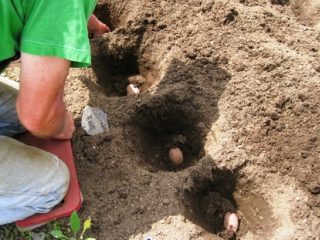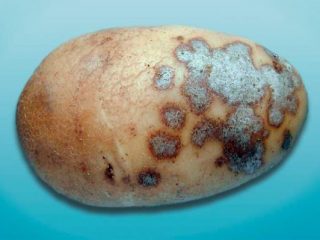Content
Potatoes Kumach are popular not only in our country, but also abroad. This variety, created by domestic breeders at the beginning of the 21st century, invariably takes prizes at tastings during agro-industrial exhibitions.
Description of the potato variety Kumach
The culture of this variety was bred for cultivation in the central part of Russia on soils rich in black soil. This is a heat-loving plant that does not tolerate sudden changes in temperature and frost and requires good lighting. At the same time, the crop does not lose its productivity in drought conditions.
The bush has an erect, medium-sized stem with bright green foliage. Approximately 33–35 days after the appearance of the first shoots, the plant blooms with sparse bright blue or purple flowers. Productivity does not depend on the intensity of flowering. The tubers are oval, neat, of the same size, with a smooth pink skin with a small number of small eyes. The flesh is creamy in color and does not change during cooking.
Potatoes of the Kumach variety ripen on average in 90 days.
Taste qualities of potatoes
This variety has won wide recognition among gardeners in our country and abroad due to its special sweetish taste. From consumer reviews of Kumach potatoes, it is clear that both children and adults like dishes made from it. The culture was bred specifically for frying and baking; Mashed potatoes and French fries are especially successful.
Potatoes Kumach are varieties with a high starch content - its tubers contain from 12% to 18% of this component. Due to this composition, it is often used as a raw material in starch production.
Pros and cons of the Kumach variety
According to farmers, the Kumach potato variety has characteristics that distinguish it favorably from other types of this crop:
- unique taste qualities;
- high productivity;
- unpretentiousness: the variety tolerates drought well, is resistant to potato diseases and pests;
- does not deteriorate for a long time during long-term transportation and storage;
- commercial success: sells well due to the above qualities.
The disadvantages are not so significant: the disadvantage can be considered its demands on light and temperature conditions, as well as the susceptibility of plants to nematode attacks.
Planting and caring for potatoes Kumach
Despite its unpretentiousness, growing Kumach potatoes requires some preparation. Main activities – watering, removal weed, hilling, fertilizing, loosening.
Selection and preparation of a landing site
From the description of the Kumach potato it follows that this variety has special requirements for light, so the best option would be to plant from the northern part of the site to the southern part - this way each plant will receive a sufficient amount of sunlight.
Agronomists recommend choosing soil on which flax, grains or legumes were previously planted. But areas where dioecious plants grew are not suitable for cultivation.
Preparation of planting material
To increase productivity and protect against diseases and pests, it is recommended to disinfect planting material. Typically, gardeners use a solution of potassium permanganate for this purpose. 1 g of powder is added to 10 liters of water and the tubers are immersed in the solution for 30 - 40 minutes. After this, just before planting, they are sprinkled with wood ash. It is also recommended to make transverse cuts on the tubers to stimulate the growth of the maximum number of eyes.
You can also use classic preparation methods: heating and germination. The first option involves keeping the tubers at a temperature of +25°... +27°C for 5–7 days. In the second case, the potatoes are laid out in the light and left at a temperature of +12°... +15°C for 20–30 days. Every 5-7 days they are sprayed with water.
Landing rules
When planting potato seed material Kumach, it will not be superfluous to put a small amount of bird droppings in each hole.
The distance between bushes should be about 60 cm, between rows - at least 40 cm; planting material is buried no more than 15 cm. This planting provides each plant with a sufficient amount of sunlight, making it easier to care for and subsequently harvest.
Watering and fertilizing
Potatoes Kumach are drought-resistant, so watering is sufficient up to 3 times per season. The best time for this is evening hours. You can water both at the root and along the furrows, with at least 3 liters of water per plant.
The first stage of feeding is carried out during the period of active plant growth. A mixture of humus and urea is well suited for this. The second stage of fertilization is carried out in order to stimulate flowering. During this period, a mixture of potassium sulfate and ash is used. During the formation of tubers, the third stage of feeding is carried out using potassium superphosphate.
Some gardeners claim that you can fertilize Kumach potatoes only once a season. To do this, bird droppings or cow manure diluted with water are sufficient. Each bush should contain at least 2 liters of solution.
Loosening and weeding
Potatoes Kumach, like other varieties of this crop, take a long time to germinate, so already in the first week after planting weeds appear on the soil. Weeding, along with loosening, provides air access to the roots and stimulates the formation of large tubers. The soil is loosened on a warm, dry sunny day. This treatment destroys up to 80% of weeds.
Hilling
Hilling is another weed control technique that can improve crop yields. The procedure involves sprinkling moist, loose soil onto the plant stem. The first hilling is carried out when the stem is about 14 cm high, the second - before flowering begins.
Diseases and pests
Potato Kumach is a variety resistant to most diseases and pests. However, it is at risk of being attacked by a nematode. The main signs are curling of the leaves, the appearance of unusual spots, bending of the stems, and delayed flowering. An effective means of pest control is Tiazon.
Chicken and cow manure can also be used as nematode control.
Potato yield
The root system of each plant contains 10–20 tubers. With proper care, you can harvest up to 25 root vegetables from one bush. The weight of one tuber is on average 200 g, many gardeners manage to provide care in which this figure increases to 250 g. From 1 hectare you can get up to 1 ton of Kumach potatoes.
Harvesting and storage
Tubers of Kumach, like other types of potatoes, can be harvested when the bushes begin to bloom. This is an early harvest. The timing of harvesting root crops that are completely ready for storage depends on the region.
The root system is carefully lifted with a pitchfork and the bush is pulled out. It is best to harvest potatoes in dry, windy weather. This way it will be better stored and less susceptible to rotting.
When the harvest is harvested, the tubers are sorted, all damaged potatoes are selected, and those that are stored are sprayed with a solution of copper sulfate (2 g per 10 liters of water). It is best to store potatoes in a dark, dry room at a temperature of +2°... +4°C.
Conclusion
Potato Kumach is an attractive variety for agricultural farms and amateur gardeners. High yield, unpretentiousness, resistance to diseases and pests and excellent taste make it increasingly popular. With proper care, this variety will delight you with beautiful, high-quality root crops that will be stored until the next harvest.













The first year I planted Kumach and several other varieties. In appearance, Kumach is a strong, strong bush, the most spectacular among others. Planted on May 16 in the Moscow region.It’s too early to dig, only August 1st tomorrow. But many other varieties have already fallen over and withered, or simply fallen apart and don’t look very good.
They promise 20 tubers from a bush, it’s hard to believe, but it’s great if it happens!